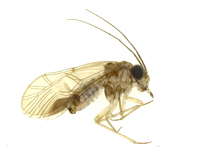Abstract
Eight species of copepods belonging to the family Dirivultidae (Siphonostomatoida) are described from deep-water hydrothermal vent fields on the Central Indian Ridge in the Indian Ocean. Aphotopontius limatulus Humes, 1987, previously known only from the East Pacific, is included. The other seven species are new, as follows: Aphotopontius kiost n. sp., A. muricatus n. sp., Benthoxynus constrictus n. sp., Stygiopontius spinifer n. sp., S. horridus n. sp., S. geminus n. sp., and S. quadripaxillifer n. sp. The copepodid I stage of S. horridus n. sp. is also described. This is the first record on copepods living on hydrothermal vent fields in the Indian Ocean.
References
Copley, J.T., Marsh, L., Glover, A.G., Hühnerbach, V., Nye, V.E., Reid, W.D.K., Sweeting, C.J., Wigham, B.D. & Wiklund, H. (2016) Ecology and biogeography of megafauna and macrofauna at the first known deep-sea hydrothermal vents on the ultraslow-spreading Southwest Indian Ridge. Scientific Reports, 6, 1–13.
https://doi.org/10.1038/srep39158
Gollner, S., Ivanenko, V.N., Arbizu, P.M. & Bright, M. (2010) Advances in taxonomy, ecology, and biogeography of Dirivultidae (Copepoda) associated with chemosynthetic environments in the deep sea. PLoS ONE, 5, e9801.
https://doi.org/10.1371/journal.pone.0009801
Hashimoto, J., Ohta, S., Gamo, T., Chiba, H., Yamaguchi, T., Tsuchida, S., Okudaira, T., Watabe, H., Yamanaka, T. & Kitazawa, M. (2001) First hydrothermal vent communities from the Indian Ocean discovered. Zoological Science, 18, 717–721. https://doi.org/10.2108/zsj.18.717
Humes, A.G. (1984) Benthoxynus spiculifer n. gen., n. sp. (Copepoda: Siphonostomatoida) associated with Vestimentifera (Pogonophora) at a deep-water geothermal vent off the coast of Washington. Canadian Journal of Zoology, 62, 2594–2599.
https://doi.org/10.1139/z84-380
Humes, A.G. (1987) Copepoda from deep-sea hydrothermal vents. Bulletin of Marine Science, 41, 645–788.
Humes, A.G. (1988) Copepoda from deep-sea hydrothermal vents and cold seeps. Hydrobiologia, 167/168, 549–554.
https://doi.org/10.1007/bf00026351
Humes, A.G. (1989) Copepoda from deep-sea hydrothermal vents at the East Pacific Rise. Bulletin du Museìum National d’Histoire Naturelle, Paris, 4e Série, 11, section A, 4, 829–848.
Humes, A.G. (1990) Copepods (Siphonostomatoida) from a deep-sea hydrothermal vent at the Mariana Back-Arc Basin in the Pacific, including a new genus and species. Journal of Natural History, 24, 289–304.
https://doi.org/10.1080/00222939000770211
Humes, A.G. (1996) Deep-sea Copepoda (Siphonostomatoida) from hydrothermal sites on the Mid-Atlantic Ridge at 23° and 37°. Bulletin of Marine Science, 58, 609–653.
Humes, A.G. (1998). Copepoda from deep-sea hydrothermal sites and cold seeps: description of a new species of Aphotopontius from the East Pacific Rise and general distribution. Cahiers de Biologie Marine, 39, 51–62.
https://doi.org/10.21411/CBM.A.958AE7F7
Humes, A.G. & Gooding, R.U. (1964) A method for studying the external anatomy of copepods. Crustaceana, 6, 238–240.
https://doi.org/10.1163/156854064x00650
Humes, A.G. & Lutz, R.A. (1994) Aphotopontius acanthinus, new species (Copepoda: Siphonostomatoida), from deep-sea hydrothermal vents on the East Pacific Rise. Journal of Crustacean Biology, 14, 337–345.
https://doi.org/10.2307/1548913
Ivanenko, V.N. (1998) Deep-sea hydrothermal vent Copepoda (Siphonostomatoida, Dirivultidae) in plankton over the Mid-Atlantic Ridge (29°N), morphology of their copepodid stage. Zoologicheskii Zhurnal, 77, 1249–1256. [in Russian with English summary]
Ivanenko, V.N. & Heptner, M.V. (1998) New data on morphology and redescription of Aphotopontius mammillatus Humes, 1987 (Copepoda, Siphonostomatoida, Dirivultidae) from deep-sea hydrothermal vents in the eastern Pacific (Guaymas Basin). Journal of Marine Systems, 15, 243–254.
https://doi.org/10.1016/s0924-7963(97)00067-5
Ivanenko, V.N., Martinez Arbizu, P. & Stecher, J. (2006) Copepods of the family Dirivultidae (Siphonostomatoida) from deep-sea hydrothermal vent fields on the Mid-Atlantic Ridge at 14ºN and 5ºS. Zootaxa, 1277 (1), 1–21.
https://doi.org/10.11646/zootaxa.1277.1.1
Nakamura, K., Watanabe, H., Miyazaki, J., Takai, K., Kawagucci, S., Noguchi, T., Nemoto, S., Watsuji, T., Matsuzaki, T., Shibuya, T., Okamura, K., Mochizuki, M., Orihashi, Y., Ura, T., Asada, A., Daniel, M., Koonjul, M., Singh, M., Beedessee, G., Bhikajee, M. & Tamaki, K. (2012) Discovery of new hydrothermal activity and chemosynthetic fauna on the Central Indian Ridge at 18–20ºS. PLoS One, 7, e32965.
https://doi.org/10.1371/journal.pone.0032965
Schander, C., Rapp, H.T., Kongsrud, J.A., Bakken, T., Bberge, J., Cochrane, S., Oug, E., Byrkjedal, I., Todt, C., Cedhagen, T., Fosshagen, A., Gebrul, A., Larsen, K., Levin, L., Obst, M., Pleijel, F., Stӧhr, S., Warén, A., Mikkelsen, T., Hadler-Jacobsen, S., Keuning, R., Petersen, K.H., Thorseth, I.H. & Pedersen, R.B. (2010) The fauna of hydrothermal vents on the Mohn Ridge (North Atlantic). Marine Biology Research, 6, 155–171.
https://doi.org/10.1080/17451000903147450
Teixeira, S., Cambon-Bonavita, M.-A., Serrão, E.A., Daniel Desbruyéres, D. & Arnaud-Haond, S. (2011) Recent population expansion and connectivity in the hydrothermal shrimp Rimicaris exoculata along the Mid-Atlantic Ridge. Journal of Biogeography, 38, 564–574.
https://doi.org/10.1111/j.1365-2699.2010.02408.x
Tunnicliffe, V., McArthur, A.G. & McHugh, D. (1998) A biogeographical perspective of the deep-sea hydrothermal vent fauna. Advances in Marine Biology, 34, 355–442.
https://doi.org/10.1016/s0065-2881(08)60213-8
Van Dover, C.L., Humphris, S.E., Fornari, D., Cavanaugh, C.M., Collier, R., Goffredi, S.K., Hashimoto, J., Lilley, M.D., Reysenbach, A.L., Shank, T.M., Von Damm Banta, K.L., Gallant, R.M., Gӧtz, D., Green, D., Hall, J., Harmer, T.L., Hurtado, L.A., Johnson, P., McKiness, Z.P., Meredith, C., Olsen, E., Pan, I.L., Turnipseed, M., Won, Y., Young, III C.R. & Verijenhoek, R.C. (2001) Biogeography and ecological setting of Indian Ocean hydrothermal vents. Science, 294, 818–823.
https://doi.org/10.1126/science.1064574
Watanabe, H. & Beedessee, G. (2015) Vent fauna on the Central Indian Ridge. In: Ishibashi, J.-I., Okino, K. & Sunamura, M. (Eds.), Subseafloor Biosphere Linked to Hydrothermal Systems, TAIGA Concept. Springer, Japan, Tokyo, pp. 205–211. https://doi.org/10.1007/978-4-431-54865-2_16

